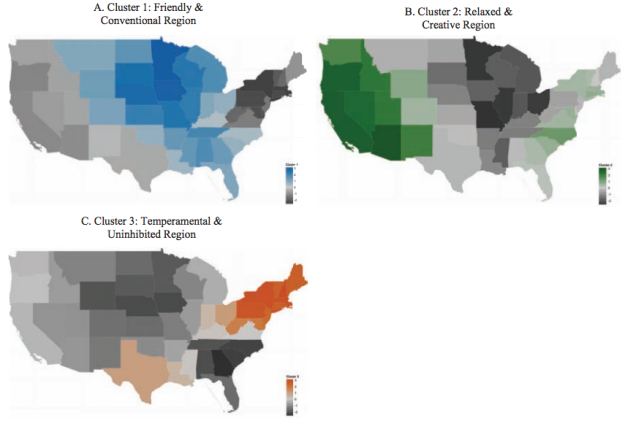US Personality Map Breaks Down Population: How Health Indicators Could Reveal Where You Live

The conventional wisdoms held about regions of the United States may be more than stereotype, a new study finds, as more people in the Northeast really are more neurotic and temperamental, while people down South do indeed show more hospitality and extraversion. The researchers behind the study used their data to form a personality map, which, among other telling factors, uses health to describe where various populations end up.
“Personality” was measured according to psychology’s Big Five personality traits, which include openness, conscientiousness, extraversion, agreeableness, and neuroticism. Through several samples of data comprising nearly 1.6 million respondents, the researchers arrived at three distinct regions of the U.S. that, they believe, describe the country unlike ever before.
"This analysis challenges the standard methods of dividing up the country on the basis of economic factors, voting patterns, cultural stereotypes or geography that appear to have become ingrained in the way people think about the United States," wrote Peter J. Rentfrow, study author and a psychologist at the University of Cambridge in the U.K. "At the same time, it reinforces some of the traditional beliefs that some areas of the country are friendlier than others, while some are more creative."
According to Rentfrow and his colleagues, the U.S. basically falls into three personality pairs: the friendly and conventional Midwest and South, the creative and relaxed West (and to a lesser extent, East) Coast, and the temperamental and uninhibited Northeast.

Such classifications, as Rentfrow argues, reinforce some traditional conceptions: consider the perennially aloof New Yorker, or the Silicon Valley techy. Or consider the sprawl of farms that blankets the country’s Breadbasket.
But the researchers didn’t stop at mere personality tests. Their analysis sought to draw links between economic, social, and health factors to the people residing in each of these regions, hoping to perhaps implicate psychological forces as mediating or causal factors in residence.
In terms of health, they defined the variable according to “Well-being” and “Health behavior,” which basically described how healthy people were and how healthy they tried to be. High measures of well-being indicated low mortality rates and low rates of diseases and disorders. High measures of health behavior indicated frequent exercise and low rates of smoking and alcohol abuse. The team found the relaxed and creative region — the West and East Coasts — correlated pretty high with both factors. Meanwhile, the conventional and friendly Midwest and South showed negative associations with both.
The reasons behind this trend are debatable, but certain indicators quickly emerge. For one, coastal states naturally tend to pack their citizens into dense cities, with suburbs accounting for smaller portions of the group. Fewer suburbs mean more overall walking and greater use of public transportation. These, coupled with the study finding coastal regions to be more politically liberal and focused on innovation, make for a population of people more concerned with informed diets and habits.
Meanwhile, the more conventional and friendlier states rely on forms of social capital — roughly speaking, their social networks. Large families with tight-knit neighborhoods, in towns where everyone knows one another, have an abundance of social capital. The city-dwelling bachelor who lives alone, interacting only with his coworkers and barista, tends to have far less social capital.
These tendencies are reflected in the five basic personality domains, as well. Southerners and Midwesterners were shown to be more extroverted, agreeable, and conscientious — three traits people would likely associate with people who are friendly. Meanwhile, those in the Northeast and Mid-Atlantic regions rated low in all three traits, yet very high in neuroticism and openness.
Overall, the researchers said the distinct personality breakdowns by region likely have something to do with migration patterns. Historically, immigrants in the U.S. were received on the coasts. Natural ethnic diversity eventually turned into intellectual diversity, and then into an appetite for future diversity. In the meantime, America’s heartland remained largely agricultural and less idea-based. Today, these regions have been cemented in their personalities — people who seek a more relaxed lifestyle travel down South, while those who want to jumpstart a career hug a coastline.
“By showing how these psychological configurations relate to important social indicators,” the researchers concluded, “the present work underscores the value of this new way of thinking.”



























